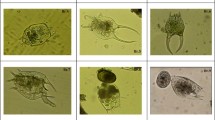Abstract
Loch Lomond is the second largest body of freshwater in Great Britain. It is a long, narrow lake (36.4 km long, 8.8 km wide). The northern basin is fjord-like and surrounded by a mountainous, base-poor, rocky catchment. In contrast, the southern basin is much broader and shallower with a mainly lowland, calcareous, agricultural catchment. This causes a trophic gradient along the length of the loch that runs from the oligotrophic northern basin to the more mesotrophic southern basin. Rotifer samples were collected at monthly intervals between May and October 2002 at three locations along the length of the loch. More than 12 species were found, the commonest of which were Keratella cochlearis (Gosse) and Trichocerca stylata (Gosse). Although the species composition of the rotifer community varied very little among the sites, rotifer abundance increased markedly from north to south, apparently reflecting the trophic gradient along the length of the loch. The results suggest that rotifer abundance may be a more sensitive indicator of trophic state, and changes in trophic state, than species composition.
Similar content being viewed by others
References
InstitutionalAuthorNameAmerican Public Health Association (1975) ArticleTitleStandard Methods for the Examination of Wastewater Publ. American Public Health Association Washington 476 481–482
B. Berzins B. Pejler (1989) ArticleTitleRotifer occurrence and trophic degree Hydrobiologia 182 171–180 Occurrence Handle10.1007/BF00006043
G. A. Best I. Traill (1994) ArticleTitleThe physico-chemical limnology of Loch Lomond Hydrobiologia 290 29–37
E. C. Blancher (1984) ArticleTitleZooplankton-trophic state relationships in some north and central florida lakes Hydrobiologia 109 251–263 Occurrence Handle10.1007/BF00007743
I. C. Duggan J. D. Green R. J. Shiel (2001) ArticleTitleDistribution of rotifers in North Island, New Zealand, and their potential use as bioindicators of lake trophic state Hydrobiologia 446/447 155–164 Occurrence Handle10.1023/A:1017503407240
J. Ejsmont-Karabin A. Hillbricht-Ilkowsks (1994) ArticleTitleIllustration of the eutrophication process: comparison of rotifers from Mikolajskie Lake in the years 1989–1990 and 1963–1964 Polski Archiwum Hydrobiologii 41 477–487
M. S. Evans (1986) ArticleTitleLake Huron rotifer and crustacean zooplankton, April–July, 1980 Great Lakes Research 12 281–292
D. R. Fuller R. S. Stemberger J. E. Gannon (1977) ArticleTitleLimnetic rotifers as indicators of trophic change Journal of the Elisha Mitchell Science Society 93 104–113
J. E. Gannon R. S. Stemberger (1978) ArticleTitleZooplankton (especially Crustacea and rotifers) as indicators of water quality Transactions American Microscopical Society 97 16–35
Gunn, I. D. M. & L. May, 1997. Analysis of 1996 zooplankton samples – Loch Leven NNR. Report to Scottish Natural Heritage, 18 pp
Herzig A., 1979. The zooplankton of the open lake. In Löffler, H. (ed.), Neusiedlersee, Limnology of a shallow lake in Central Europe. Dr W Junk Publishers, The Hague. Monographie Biologicae 37: 281–335
D. P. Hewitt D. G. George (1987) ArticleTitleThe population dynamics of Keratella cochlearis in a hypereutrophic tarn and the possible impact of predation by roach Hydrobiologia 147 221–227 Occurrence Handle10.1007/BF00025746
A. Karabin (1985) ArticleTitlePelagic zooplankton variation in the process of lake eutrophication I. Structural and quantitative features Ekologica Polska 33 567–616
W. Koste (1976) Rotatoria: Die Rädertiere Mitteleuropas Gebrüder Borntraeger Berlin, Stuttgart 673
F. J. H. Mackereth J. Heron J. F. Talling (1978) Water analysis: some revised methods for limnologists Freshwater Biological Association Scientific Publication, Titus Wilson & Son Ltd. Kendal
Maitland, P. S., 1981. Introduction and catchment analysis. In Maitland, P. S. (ed.) , Dr W Junk Publishers, The Hague, pp. 1–27.
Maitland, P. S., I. R. Smith, A. E. Bailey-Watts, B. D. Smith& A. Lyle, 1981. Comparison and synthesis. In Maitland, P. (ed.), Dr W Junk Publishers, The Hague, pp. 253–282.
L. K. Matveeva (1991) ArticleTitlePlanktonic rotifers as indicators of trophic state Bulletin of the Moscow Naturalist’s Society, Biology Section 96 54–62
J. Murphy J. P. Riley (1962) ArticleTitleA modified single-solution method for the determination of phosphate in natural waters Analytica Chimica Acta 27 31–36 Occurrence Handle10.1016/S0003-2670(00)88444-5
J. Murray L. Pullar (1910) Bathymetrical survey of the freshwater lochs of Scotland Challenger Office Publishers Edinburgh
J. D. Orcutt M. L. Pace (1984) ArticleTitleSeasonal dynamics of rotifer and crustacean zooplankton populations in a eutrophic, monomictic lake with a note on rotifer sampling techniques Hydrobiologia 119 73–80 Occurrence Handle10.1007/BF00016866
P. P. Pomeroy (1994) ArticleTitleZooplankton in Loch Lomond: perspectives, predation and powan Hydrobiologia 290 75–90
S. Radwan B. Popiolek (1989) ArticleTitlePercentage of rotifers in spring zooplankton in lakes of different trophy Hydrobiologia 186/187 235–238 Occurrence Handle10.1007/BF00048918
P. Schaber (1976) ArticleTitleRotatorien und Crustaceen des Piburger See (1973–1975) Abteilung Limnologie/Institut für Zoologie, Universität Innsbruck, Jahresbericht 2 78–94
Smith, I. R., A. A. Lyle & A. J. Rosie, 1981. Comparative physical limnology. In Maitland, P.S. (ed.) , Dr W Junk Publishers, The Hague, pp. 29–65.
R. Tippett (1994) ArticleTitleAn introduction to Loch Lomond Hydrobiologia 290 11–15
N. Walz H.-J. Elster M. Mezger (1987) ArticleTitleThe development of the rotifer community structure in Lake Constance during its eutrophication Archiv für Hydrobiologie, Supplement 74 452–487
Author information
Authors and Affiliations
Corresponding author
Rights and permissions
About this article
Cite this article
May, L., O’Hare, M. Changes in Rotifer Species Composition and Abundance along a Trophic Gradient in Loch Lomond, Scotland, UK. Hydrobiologia 546, 397–404 (2005). https://doi.org/10.1007/s10750-005-4282-3
Accepted:
Issue Date:
DOI: https://doi.org/10.1007/s10750-005-4282-3




